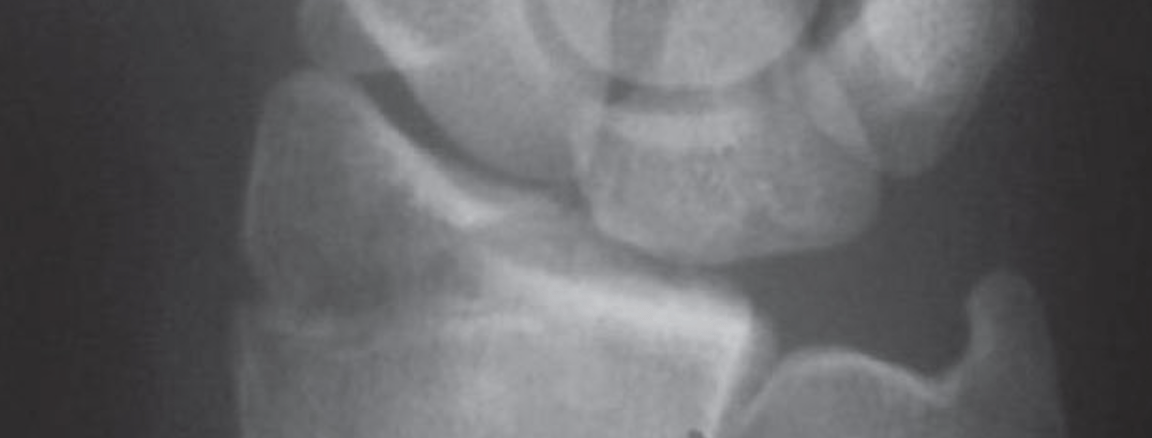Wrist fracture
What is a wrist fracture?
Distal radius fractures are common and most often result from falling onto an outstretched hand or receiving a direct blow to the wrist.
A broken wrist or wrist fracture is when one or more of the bones in the wrist is cracked or broken. The most common type of wrist fracture is called a Colles’ fracture (or distal radius fracture). This type of break is a break in the larger of the two bones in the forearm.
The bone usually breaks at the end, where it connects with the hand and thumb. Wrist fractures occur through impact – either through playing sports, having fragile bones (osteoporosis) or falling down. It is essential to treat a wrist fracture as not doing so could risk the bones healing incorrectly, which may cause problems in the future.
The radius is the larger of the two bones in the forearm. The section of the radius that is connected to the wrist joint is called the distal radius. A fracture in this area is sometimes called a “broken wrist.”
Symptoms of a wrist fracture
• Pain
• Bruising
• Swelling
• Stiffness and inability to move the fingers or thumb
• Numbness in the wrist or hand
Medical tests to diagnose a wrist fracture
What are the causes of wrist fracture?
The main causes of a wrist fracture are car accidents, sports injuries and falls.
Can a wrist fracture be prevented?
Although you cannot prevent unforeseen events, there are measures that can help reduce the chances of injury.
You can improve your bone strength by eating a healthy diet with enough calcium and vitamin D.
Exercising frequently and being sure to do weight-bearing exercises too. Stop smoking.To avoid falls, it is advised to wear practical shoes (not high-heels or platforms). Move any tripping hazards. Make sure your vision is fine or your glasses prescription is correct.
When playing sports, make sure protective gear is being used.
Treatments for a wrist fracture
If the bones are misaligned, they will need to be reset so that they heal in the correct position. This can be painful, so anaesthesia can be given. A cast will be needed for up to 8 weeks, depending on how bad the fracture is.
There are different ways of fixing the wrist. These include plaster, Volar plating, fragment specific plating or a spanning plate. All options are described in the video below.
Medications for a wrist fracture
To manage any pain, over-the-counter pain medication can be taken.
Which do you need to know before surgery?
If you go to our downloads section, you will find detailed description of the benefits and risks of these surgical procedures.
What is a wrist sprain?
A wrist sprain occurs when the strong ligaments that support the wrist stretch beyond their limits or tear. This occurs when the wrist is bent or twisted forcefully, such as caused by a fall onto an outstretched hand. Wrist sprains are common injuries. They can range from mild to severe, depending on how much damage there is to the ligaments.
Treatment
Treatment for a wrist sprain depends upon the severity of the injury.
Home Care
Mild wrist sprains will usually improve with home treatment that includes the RICE protocol:
- Rest. Try not use your wrist for at least 48 hours.
- Ice. Apply ice immediately after the injury to keep the swelling down. Use cold packs for 20 minutes at a time, several times a day. Do not apply ice directly on the skin.
- Compression. Wear an elastic compression bandage to reduce swelling.
- Elevation. As often as possible, rest with your wrist raised up higher than your heart.
Additionally, nonsteroidal anti-inflammatory drugs (NSAIDs), such as aspirin or ibuprofen, can help reduce pain and swelling. If pain and swelling persist for more than 48 hours, however, see a doctor.
Nonsurgical Treatment
Moderate sprains may need to be immobilized with a wrist splint for one week or more. Because immobilization may cause some stiffness in your wrist, your doctor may recommend some stretching exercises to help you regain full mobility.
A wrist splint.
Surgical Treatment
Severe sprains may require surgery to repair the fully torn ligament. Surgery involves reconnecting the ligament to the bone or using a tendon graft to reconstruct the injured ligament. Your doctor will talk with you about which option is best in your situation.
Surgery is followed by a period of rehabilitation that includes exercises to strengthen your wrist and restore range of motion. Although the ligament usually heals in 8 to 12 weeks, it can take from 6 to 12 months for a full recovery. The length of the recovery process and your outcomes will depend on the severity of the sprain.
Prevention
Because wrist sprains usually result from a fall, be careful when walking in wet or slippery conditions. Wrist sprains also occur during sports, such as skating, skateboarding, and skiing. Wearing wrist guards or protective tape when participating in these activities will help support your wrist and can prevent it from bending too far backward if you fall.


